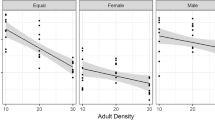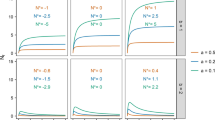Abstract
Many ovipositing mosquitoes, as well as other species, can detect biotic factors that affect fitness. However, a female mosquito seeking a high quality oviposition site (e.g. one with low risk of predation and competition to her progeny) must often balance the competing risk of increasing probability of mortality to herself while she continues to search, against increased probability of finding a high quality site. Such oviposition site selection may affect adult population size. We examined a female mosquito’s expected strategy of oviposition site selection under conditions of varying predator prevalence and adult mortality risk, by combining a detailed structured population model with a Markov chain implementation of the adult behavioural process. We used parameter values from the specific mosquito-predator system, Culiseta longiareolata-Notonecta maculata, although the overall results can be generalised to many mosquito species. Our model finds the evolutionarily stable strategy of oviposition site selection for different parameter combinations. Our model predicts that oviposition strategy does not vary smoothly with varying environmental risk of adult mortality, but that certain oviposition strategies become unstable at some parameter values. Mosquitoes will distribute their reproductive effort between breeding sites of varying predation risk only when adult mortality is low or larval competition high. Our model predicts that females will continue searching for predator-free pools, rather than oviposit in the first site encountered, regardless of the risk of mortality to the adult. The ecological basis for a reproductive strategy with alternative behaviours is important for understanding the effect of biotic factors on the population dynamics of mosquitoes, and for the development of biological control strategies, such as the dissemination of predator-cue chemicals.








Similar content being viewed by others
References
Abrams PA, Cressman R, Křivan V (2007) The role of behavioral dynamics in determining the patch distributions of interacting species. Am Nat 169:505–518
Angelon KA, Petranka JW (2002) Chemicals of predatory mosquitofish (Gambusia affinis) influence selection of oviposition site by Culex mosquitoes. J Chem Ecol 28:797–806
Austad SN (1984) A classification of alternative reproductive behaviors and methods for field-testing ESS models. Am Zool 24:309
Binckley CA, Resetarits WJ (2002) Reproductive decisions under threat of predation: squirrel treefrog (Hyla squirella) responses to banded sunfish (Enneacanthus obesus). Oecologia 130:157–161
Bishop D, Cannings C (1978) A generalized war of attrition. J Theor Biol 70:85–124
Black AR, Dodson SI (1990) Demographic costs of Chaoborus-induced phenotypic plasticity in Daphnia pulex. Oecologia 83:117–122
Blaustein L (1998) Influence of the predatory backswimmer, Notonecta maculata, on invertebrate community structure. Ecol Entomol 23:246–252
Blaustein L (1999) Oviposition habitat selection in response to risk of predation: consequences for populations and community structure. In: Wasser SP (ed) Evolutionary processes and theory: modern perspectives. Kluwer Academic Publishers, pp 441–456
Blaustein L, Kotler BP (1993) Oviposition habitat selection by Culiseta longiareolata: effects of immature conspecifics, tadpoles and food levels. Ecol Entomol 18:104–108
Blaustein L, Margalit J (1995) Spatial distributions of Culiseta longiareolata (Culicidae: Diptera) and Bufo viridis (Amphibia: Bufonidae) among and within desert pools. J Arid Environ 29:199–211
Blaustein L, Margalit J (1996) Priority effects in temporary pools: nature and outcome of mosquito larva-toad tadpole interactions depend on order of entrance. J Anim Ecol 65:77–84
Blaustein L, Whitman DW (2009) Behavioral plasticity to risk of predation: oviposition site selection by a mosquito in response to its predators. In: Whitman D, Ananthakrishnan TN (eds) Phenotypic plasticity of insects: mechanisms and consequences. Science Pub Inc, Plymouth, pp 263–280
Blaustein L, Kotler BP, Ward D (1995) Direct and indirect effects of a predatory backswimmer (Notonecta maculata) on community structure of desert temporary pools. Ecol Entomol 20:311–318
Blaustein L, Kiflawi M, Eitam A, Mangel M, Cohen JE (2004) Oviposition habitat selection in response to risk of predation in temporary pools: mode of detection and consistency across experimental venue. Oecologia 138:300–305
Chesson J (1984) Effect of notonectids (Hemiptera: Notonectidae) on mosquitoes (Diptera: Culicidae): predation or selective oviposition. Environ Entomol 13:531–538
Choh Y, Takabayashi J (2010) Predator avoidance by phytophagous mites is affected by the presence of herbivores in a neighboring patch. J Chem Ecol 36:614–619
Cushing J (1996) Nonlinear matrix equations and population dynamics. In: Structured-population models in marine, terrestrial, and freshwater systems. Kluwer Academic Publishers, pp 205–243
Dawkins R (1980) Good strategy or evolutionarily stable strategy? In: Barlow GW, Silverberg J (eds) Sociobiology: beyond nature/nurture?
Eitam A, Blaustein L (2004) Oviposition habitat selection by mosquitoes in response to predator (Notonecta maculata) density. Physiol Entomol 29:188–191
Eitam A, Blaustein L, Mangel M (2002) Effects of Anisops sardea (Hemiptera: Notonectidae) on oviposition habitat selection by mosquitoes and other dipterans and on community structure in artificial pools. Hydrobiologia 485:183–189
Eitam A, Norena C, Blaustein L (2004) Microturbellarian species richness and community similarity among temporary pools: relationships with habitat properties. Biodivers Conserv 13:2107–2117
Fretwell SD, Lucas HL (1969) On territorial behavior and other factors influencing habitat distribution in birds. Acta Biotheor 19:16–36
Holt RD (1985) Population dynamics in two-patch environments: some anomalous consequences of an optimal habitat distribution. Theor Popul Biol 28:181–208
Kiflawi M, Blaustein L, Mangel M (2003a) Oviposition habitat selection by the mosquito Culiseta longiareolata in response to risk of predation and conspecific larval density. Ecol Entomol 28:168–173
Kiflawi M, Blaustein L, Mangel M (2003b) Predation-dependent oviposition habitat selection by the mosquito Culiseta longiareolata: a test of competing hypotheses. Ecol Letters 6:35–40
Kiflawi M, Eitam A, Blaustein L (2003c) The relative impact of local and regional processes on macro-invertebrate species richness in temporary pools. J Anim Ecol 72:447–452
Kiszewski A, Mellinger A, Spielman A, Malaney P, Sachs SE, Sachs J (2004) A global index representing the stability of malaria transmission. Am J Trop Med Hyg 70:486–498
Maciá A (2009) Effects of larval crowding on development time, survival and weight at metamorphosis in Aedes aegypti (Diptera: Culicidae). Revista de la Sociedad Entomológica Argentina 68:107–114
Manda H, Gouagna LC, Foster WA, Jackson RR, Beier JC, Githure JI, Hassanali A (2007) Effect of discriminative plant-sugar feeding on the survival and fecundity of Anopheles gambiae. Malar J 6:113
Mangel M, Clark CW (1988) Dynamic modeling in behavioral ecology. Princeton University Press, Princeton
Manoukis NC, Touré MB, Sissoko I, Doumbia S, Traoré SF, Diuk-Wasser MA, Taylor CE (2006) Is vector body size the key to reduced malaria transmission in the irrigated region of Niono, Mali? J Med Entomol 43:820
Mayhew PJ (1997) Adaptive patterns of host-plant selection by phytophagous insects. Oikos 79:417–428
Maynard Smith J, Price GR (1973) The logic of animal conflict. Nature 246:15–18
Munga S, Minakawa N, Zhou G, Barrack OOJ, Githeko AK, Yan G (2006) Effects of larval competitors and predators on oviposition site selection of Anopheles gambiae sensu stricto. J Med Entomol 43:221–224
Murdoch WW, Scott MA, Ebsworth P (1984) Effects of the general predator, Notonecta (Hemiptera) upon a freshwater community. J Anim Ecol 53:791–808
Murdoch WW, Chesson J, Chesson PL (1985) Biological control in theory and practice. Am Nat 125:344–366
Nakajima Y, Fujisaki K (2010) Fitness trade-offs associated with oviposition strategy in the winter cherry bug, Acanthocoris sordidus. Entomol Exp Appl 137:280–289
Reguera P, Gomendio M (2002) Flexible oviposition behavior in the golden egg bug (Phyllomorpha laciniata) and its implications for offspring survival. Behav Ecol 13:70–74
Reiskind M, Lounibos L (2009) Effects of intraspecific larval competition on adult longevity in the mosquitoes Aedes aegypti and Aedes albopictus. Med Vet Entomol 23:62–68
Reiskind MH, Wund MA (2009) Experimental assessment of the impacts of northern long-eared bats on ovipositing Culex (Diptera: Culicidae) mosquitoes. J Med Entomol 46:1037–1044
Resetarits WJ, Rieger JF, Binckley CA (2004) Threat of predation negates density effects in larval gray treefrogs. Oecologia 138:532–538
Rieger JF, Binckley CA, Resetarits WJ (2004) Larval performance and oviposition site preference along a predation gradient. Ecology 85:2094–2099
Roitberg BD, Mangel M (2010) Mosquito biting and movement rates as an emergent community property and the implications for malarial interventions. Isr J Ecol Evol 56:297–312
Root RB, Kareiva PM (1984) The search for resources by cabbage butterflies (Pieris rapae): ecological consequences and adaptive significance of Markovian movements in a patchy environment. Ecology 65:147–165
Sadeh A, Mangel M, Blaustein L (2009) Context-dependent reproductive habitat selection: the interactive roles of structural complexity and cannibalistic conspecifics. Ecol Lett 12:1158–1164
Service MW (1976) Mosquito ecology: field sampling methods. Applied Science
Shaalan EAS, Canyon DV (2009) Aquatic insect predators and mosquito control. Trop Biomed 26:223–261
Silberbush A, Blaustein L (2011) Mosquito females quantify risk of predation to their progeny when selecting an oviposition site. Funct Ecol 25:1091–1095
Silberbush A, Markman S, Lewinsohn E, Bar E, Cohen JE, Blaustein L (2010) Predator-released hydrocarbons repel oviposition by a mosquito. Ecol Lett 13:1129–1138
Singer MC, Vasco D, Parmesan C, Thomas CD, Ng D (1992) Distinguishing between ‘preference’ and ‘motivation’ in food choice: an example from insect oviposition. Anim Behav 44:463–471
Smith C, Reynolds JD, Sutherland WJ (2000) Population consequences of reproductive decisions. Proc R Soc Lond B Biol Sci 267:1327
Spencer M, Blaustein L, Cohen JE (2002a) Oviposition habitat selection by mosquitoes (Culiseta longiareolata) and consequences for population size. Ecology 83:669–679
Spencer M, Schwartz SS, Blaustein L (2002b) Are there fine-scale spatial patterns in community similarity among temporary freshwater pools? Global Ecol Biogeogr 11:71–78
Spielman A, D’Antonio M, Wallace B (2001) Mosquito: a natural history of our most persistent and deadly foe. Faber and Faber, London
Stav G, Kotler BP, Blaustein L (2010) Foraging Response to Risks of Predation and Competition in Artificial Pools. Isr J Ecol Evol 56:9–20
Stone C, Taylor R, Roitberg B, Foster W (2009) Sugar deprivation reduces insemination of Anopheles gambiae (Diptera: Culicidae), despite daily recruitment of adults, and predicts decline in model populations. J Med Entomol 46:1327
Strogatz SH (1994) Nonlinear dynamics and chaos: with applications to physics, biology, chemistry, and engineering. Westview Press, Cambridge
Styer LM, Carey JR, Wang JL, Scott TW (2007) Mosquitoes do senesce: departure from the paradigm of constant mortality. Am J Trop Med Hyg 76:111
Van Pletzen R, Van Der Linde TCDK (1981) Studies on the biology of Culiseta longiareolata (Macquart) (Diptera: Culicidae). Bull Entomol Res 71:71–79
Vonesh J, Blaustein L (2010) Predator-induced shifts in mosquito oviposition site selection: a meta-analysis and implications for vector control. Isr J Ecol Evol 56:263–279
Ward SA (1987) Optimal habitat selection in time-limited dispersers. Am Nat 129:568–579
Warner RR, Wernerus F, Lejeune P, Van Den Berghe E (1995) Dynamics of female choice for parental care in a fish species where care is facultative. Behav Ecol 6:73
Author information
Authors and Affiliations
Corresponding author
Electronic supplementary material
Below is the link to the electronic supplementary material.
Rights and permissions
About this article
Cite this article
Kershenbaum, A., Spencer, M., Blaustein, L. et al. Modelling evolutionarily stable strategies in oviposition site selection, with varying risks of predation and intraspecific competition. Evol Ecol 26, 955–974 (2012). https://doi.org/10.1007/s10682-011-9548-9
Received:
Accepted:
Published:
Issue Date:
DOI: https://doi.org/10.1007/s10682-011-9548-9




